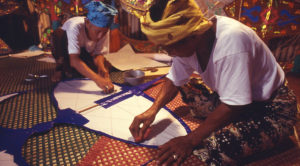
Huge, highly decorative kites (wau), made primarily in the east coast states of Kelantan and Terengganu, are noteworthy for their size, design, craftsmanship, decoration and use of colour. A wau may measure two metres (seven feet) from head to tail and 1.8 metres (six feet) across. The largest, most elaborate wau are used in kite flying competitions, while smaller ones with near-identical shapes and designs serve as decorative items.
The main component of a wau, the wings, resemble a large leaf, and are balanced by a “horn” or head on top and a bottom (tail) of varying shape. Thus, each kite is said to have a head, waist, wings and bottom. A distinct feature is a bow (busul) attached horizontally on the neck, extending on both sides of the central spine. This produces a humming sound when the kite is aloft, which is said to drive away malicious influences.

East coast kites are made in many different shapes, but the most popular and well known is the moon kite (wau bulan), which has a crescent-shaped bottom. Bird kites (wau burung) based on the parakeet, peacock or hawk, are fitted with a beak above a long neck, supplemented by a fringe of glossy coloured paper. Cat kites (wau kucing), boat kites and others are distinguished by the shapes of their tails.
The frame (rangka) of a wau is made from light, flexible bamboo, the strips measured and tied together by means of thin string. Symmetry and balance are important. The frame is then usually covered with three layers of paper. The first, consisting of plain transparent paper, covers the wingspan, the second is cut out to provide the main decoration of the kite and is pasted on the first, while the third provides additional detailed ornamentation, spreading from the central spine to the wings. Trimmings may be added to the wing tips and tail.
Traditional Malay patterns, such as meandering clouds (awan larat) or young bamboo shoots (pucuk rebung), are favoured by kite craftsmen, as are patterns based on flowers and leaves. The overlapping cut-out patterns produce a three-dimensional effect, much like open-work woodcarving.
Written in collaboration with Fiona Wong




